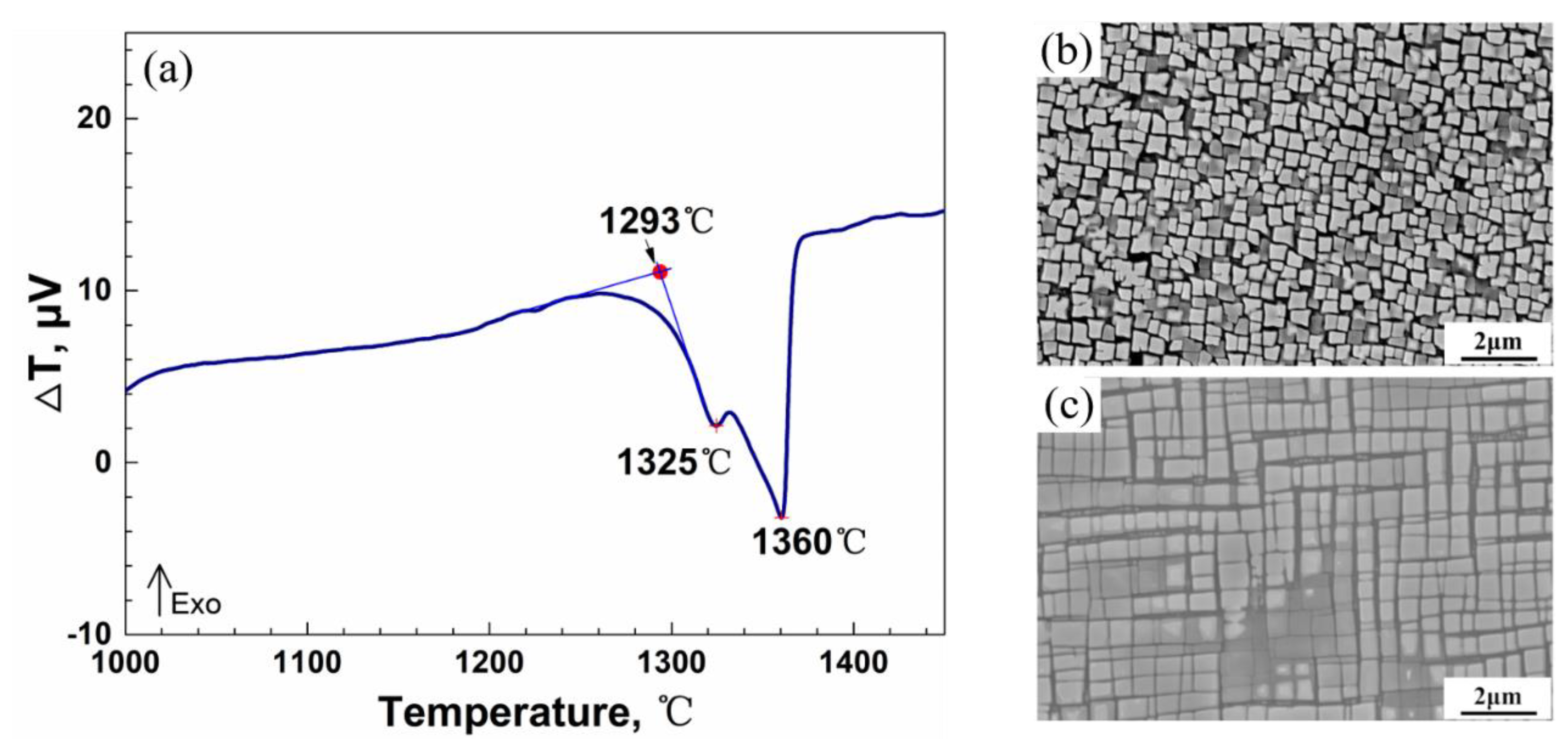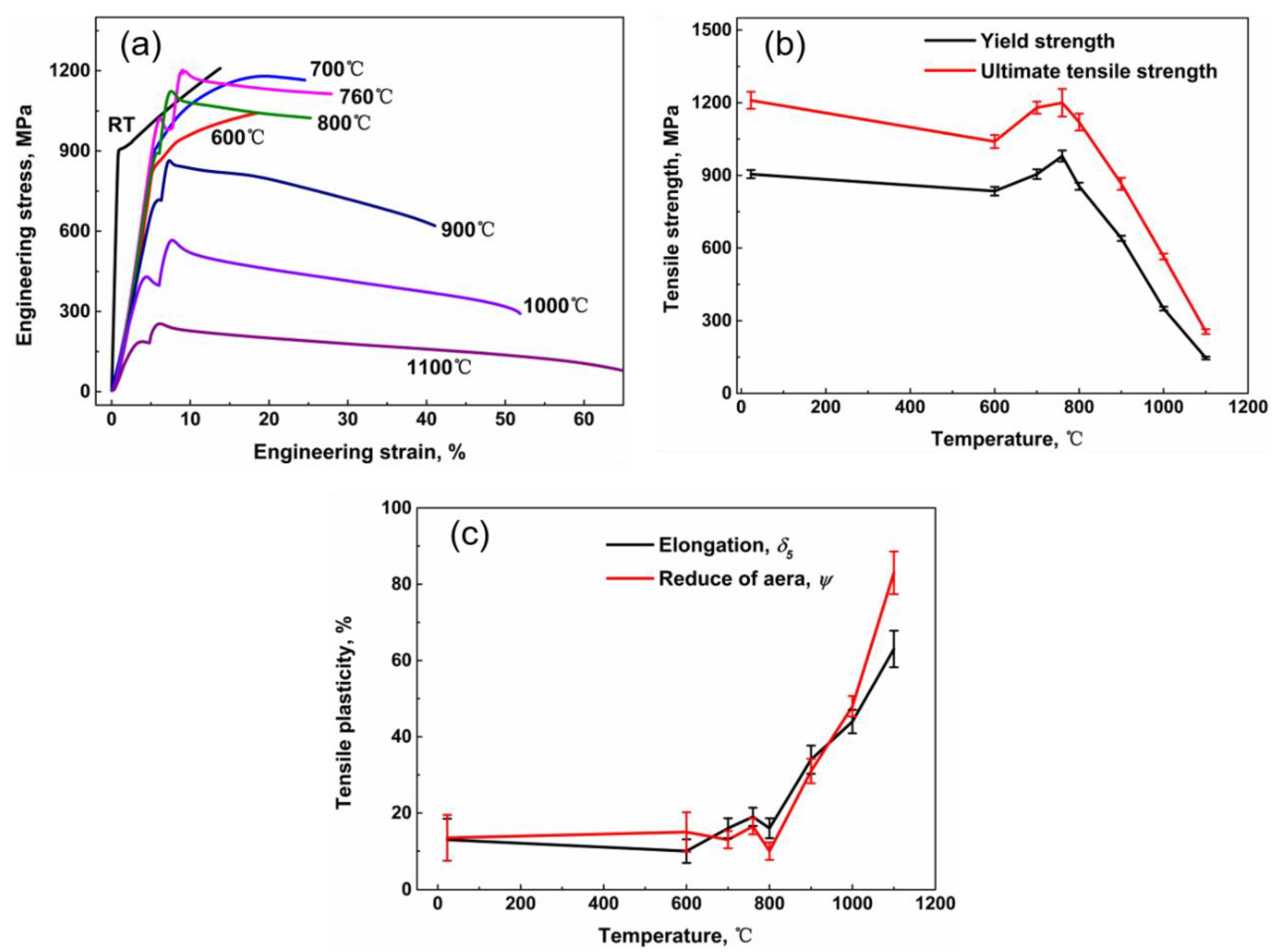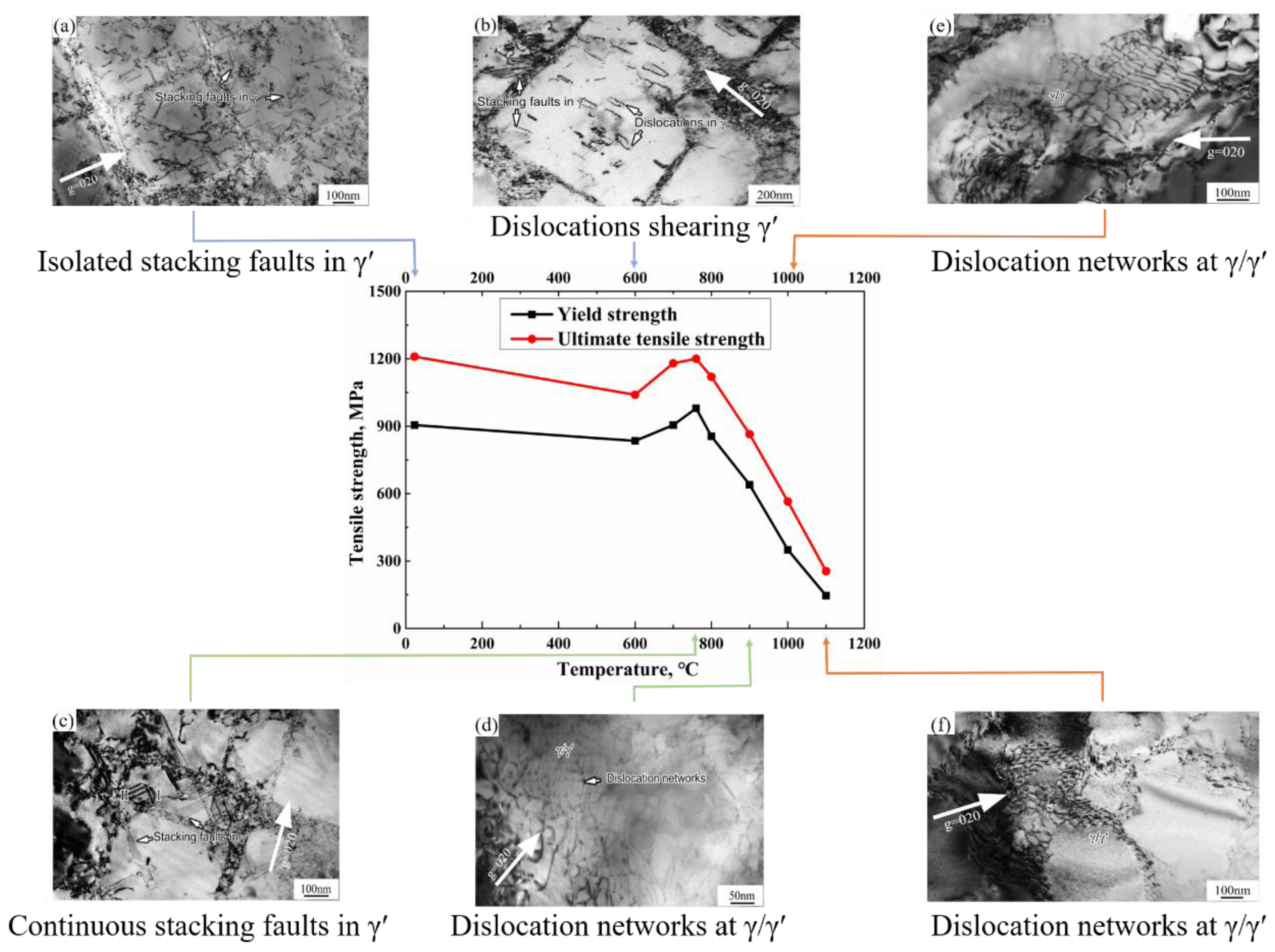Tensile Deformation and Fracture Behavior of Nickel-Based Superalloy DZ951G
Abstract
1. Introduction
2. Experimental Procedure
3. Results
3.1. Microstructures Compared between As-Cast and Heat-Treated
3.2. Tensile Behaviors
3.3. Fracture Analysis
3.4. Deformation Microstructures
3.4.1. Low Temperatures
3.4.2. Intermediate Temperatures
3.4.3. High Temperatures
4. Discussion
4.1. Stacking Fault
4.2. Relationship between Tensile Properties and Deformation Microstructures
5. Conclusions
- The tensile strength of DZ951G superalloy was enhanced at intermediate temperature by the additions of Hf and W, in which the abnormal yield point 980 MPa existed at 760 °C;
- In the present study, two types of stacking faults existed. One was isolated stacking faults below 600 °C, and another was continuous stacking faults at 760 °C. The reactions of stacking faults could also be observed;
- The main deformation mechanism below 600 °C was dislocations shearing γ′ particles, but beyond 900 °C, bypassing γ′ particles dominated. At intermediate temperature, the transition from shearing to bypass appeared. The fracture translated from brittle fracture into ductile fracture at 900 °C.
Author Contributions
Funding
Institutional Review Board Statement
Informed Consent Statement
Data Availability Statement
Acknowledgments
Conflicts of Interest
References
- Xia, W.S.; Zhao, X.B.; Yue, L.; Zhang, Z. A review of composition evolution in Ni-based single crystal superalloys. J. Mater. Sci. Technol. 2020, 44, 76–95. [Google Scholar] [CrossRef]
- Perepezko, J.H. The hotter the Engine, the better. Science 2009, 326, 1068–1069. [Google Scholar] [CrossRef]
- Tang, Y.L.; Huang, M.; Xiong, J.; Li, J.; Zhu, J. Evolution of superdislocation structures during tertiary creep of a nickel-based single-crystal superalloy at high temperature and low stress. Acta Mater. 2017, 126, 336–345. [Google Scholar] [CrossRef]
- Long, H.B.; Mao, S.C.; Liu, Y.N.; Zhang, Z.; Han, X.D. Microstructural and compositional design of Ni-based single crystalline superalloys-A review. J. Alloys Compd. 2017, 743, 203–220. [Google Scholar] [CrossRef]
- Varvenne, C.; Leyson, G.P.M.; Ghazisaeidi, M.; Curtin, W.A. Solute strengthening in random alloys. Acta Mater. 2017, 124, 660–683. [Google Scholar] [CrossRef]
- Hargather, C.Z.; Shang, S.L.; Liu, Z.K. A comprehensive first-principles study of solute elements in dilute Ni alloys: Diffusion coefficients and their implications to tailor creep rate. Acta Mater. 2018, 157, 126–141. [Google Scholar] [CrossRef]
- Arora, K.; Kishida, K.; Tanaka, K.; Inui, H. Effects of lattice misfit on plastic deformation behavior of single-crystalline micropillars of Ni-based superalloys. Acta Mater. 2018, 138, 119–130. [Google Scholar] [CrossRef]
- Zhang, Y.; Zuo, T.T.; Tang, Z.; Gao, M.C.; Dahmen, K.A.; Liaw, P.K.; Lu, Z.P. Microstructures and properties of high-entropy alloys. Prog. Mater. Sci. 2014, 61, 1–93. [Google Scholar] [CrossRef]
- Doi, M. Elasticity effects on the microstructure of alloys containing coherent precipitates. Prog. Mater. Sci. 1996, 40, 79–180. [Google Scholar] [CrossRef]
- Long, H.B.; Wei, H.; Liu, Y.N.; Mao, S.C.; Zhang, J.X.; Xiang, S.S.; Chen, Y.H.; Gui, W.M.; Li, Q.; Zhang, Z.; et al. Effect of lattice misfit on the evolution of dislocation structure in Ni-based single crystal superalloys during thermal exposure. Acta Mater. 2016, 120, 95–130. [Google Scholar] [CrossRef]
- Xia, P.C.; Yu, J.J.; Sun, X.F.; Guan, H.R.; Hu, Z.Q. Influence thermal exposure on the γ′ precipitates and tensile property of DZ951 alloy. Mater. Charact. 2007, 58, 645–651. [Google Scholar] [CrossRef]
- Xia, P.C.; Yu, J.J.; Sun, X.F.; Guan, H.R.; Hu, Z.Q. Influence of thermal exposure on the microstructure and stress rupture property of DZ951 alloy. J. Alloys Compd. 2007, 433, 125–131. [Google Scholar] [CrossRef]
- Chu, Z.K.; Yu, J.J.; Sun, X.F.; Guan, H.R.; Hu, Z.Q. Tensile property and deformation behavior of a directionally solidified Ni-based superalloy. Mater. Sci. Eng. A 2010, 527, 3010–3014. [Google Scholar] [CrossRef]
- Zheng, Y.R. Behavior of Hf in solidification of cast Ni-base superalloys. Acta Metall. 1986, 22, 119–124. [Google Scholar]
- Zhao, Y.S.; Zhang, J.; Luo, Y.S.; Li, J.; Tang, D.Z. Effect of Hf and B on high temperature low stress creep behavior of a secondgeneration Ni-based single crystal superalloy DD11. Mater. Sci. Eng. A 2016, 672, 143–152. [Google Scholar] [CrossRef]
- Cui, L.Q.; Su, H.H.; Yu, J.J.; Liu, J.J.; Jin, T.; Sun, X.F. Temperature dependence of tensile properties and deformation behaviors of nickel-base superalloy M951G. Mater. Sci. Eng. A 2017, 696, 323–330. [Google Scholar] [CrossRef]
- Zhang, P.; Yuan, Y.; Shen, S.C.; Li, B.; Zhu, R.H.; Yang, G.X.; Song, X.L. Tensile deformation mechanisms at various temperatures in a new directionally solidified Ni-based superalloy. J. Alloys Compd. 2017, 694, 502–509. [Google Scholar] [CrossRef]
- Tian, C.G.; Han, G.M.; Cui, C.Y.; Sun, X.F. Effects of Co content on tensile properties and deformation behaviors of Ni-based disk superalloys at different temperatures. Mater. Des. 2015, 88, 123–131. [Google Scholar] [CrossRef]
- Murakumo, T.; Kobayashi, T.; Koizumi, Y.; Harada, H. Creep behaviour of Ni-base single-crystal superalloys with various γ′ volume fraction. Acta Mater. 2004, 52, 3737–3744. [Google Scholar] [CrossRef]
- Qi, D.; Wang, D.; Du, K.; Qi, Y.; Lou, L.; Zhang, J.; Ye, H. Creep deformation of a nickel-based single crystal superalloy under high stress at 1033 K. J. Alloys Compd. 2018, 735, 813–820. [Google Scholar] [CrossRef]
- Zhang, P.; Yuan, Y.; Li, J.; Xu, Y.F.; Song, X.L.; Yang, G.X. Tensile deformation mechanisms in a new directionally solidified Ni-based superalloy containing coarse γ′ precipitates at 650 °C. Mater. Sci. Eng. A 2017, 702, 343–349. [Google Scholar] [CrossRef]
- Ma, S.; Carroll, L.; Pollock, T.M. Development of γ phase stacking faults during high temperature creep of Ru-containing single crystal superalloys. Acta Mater. 2007, 55, 5802–5812. [Google Scholar] [CrossRef]
- Qi, D.Q.; Fu, B.D.; Du, K.; Yao, T.T.; Cui, C.Y.; Zhang, J.X.; Ye, H.Q. Temperature effects on the transition from Lomer-Cottrell Locks to deformation twining in a Ni-Co-based superalloy. Scr. Mater. 2016, 125, 24–28. [Google Scholar] [CrossRef]
- Kovarik, L.; Unocic, R.R.; Li, P. Sarosi, C. Shen, Y. Wang, M.J. Mills, Microtwinning and other shear mechanisms at intermediate temperatures in Ni-based superalloys. Prog. Mater. Sci. 2009, 54, 839–873. [Google Scholar] [CrossRef]
- Yang, Y.H.; Yu, J.J.; Sun, X.F.; Jin, T.; Guan, H.R.; Hu, Z.Q. The influence of long-term thermal exposure on intermediate temperature brittleness behavior of a Nickel-base superalloy. Mater. Charact. 2012, 66, 30–37. [Google Scholar] [CrossRef]
- Wang, X.G.; Liu, J.L.; Jin, T.; Sun, X.F.; Hu, Z.Q.; Do, J.H.; Choi, B.G.; Kim, I.S.; Jo, C.Y. Dislocations motion during high-temperature low-stress creep in Ru-free and Ru-containing single-crystal superalloys. Mater. Des. 2015, 67, 543–551. [Google Scholar] [CrossRef]
- Dang, C.X.; Zhang, P.; Li, J.; Gao, Z.H.; Li, B.; Gong, X.F.; Song, X.L. The role of <112> {111} slip in the initial plastic deformation of Ni-base superalloys at room temperature. Mater. Charact. 2020, 170, 110648. [Google Scholar] [CrossRef]
- Décamps, B.; Raujol, S.; Coujou, A.; Pettinari-Sturmel, F.; Caron, P. On the shearing mechanism of gamma’ precipitates by a single a/2〈110〉 dissociated matrix dislocations in Ni–based superalloys. Philos. Mag. A 2004, 84, 91–107. [Google Scholar] [CrossRef]
- Wang, X.G.; Liu, J.L.; Jin, T.; Sun, X.F. The effect of ruthenium additions on tensile deformation mechanisms of single crystal superalloys at different temperatures. Mater. Des. 2014, 63, 286–293. [Google Scholar] [CrossRef]
- Xiong, X.; Quan, D.; Dai, P. Tensile behavior of nickel-base single-crystal superalloy DD6. Mate. Sci. Eng. A 2015, 636, 608–612. [Google Scholar] [CrossRef]
- Tian, N.; Tian, S.; Yan, H. Deformation mechanisms and analysis of a single crystal nickel-based superalloy during tensile at room temperature. Mater. Sci. Eng. A 2019, 744, 154–162. [Google Scholar]
- Agudo Jácome, L.; Nörtershäuser, P.; Somsen, C.; Dolouhý, A.; Eggeler, G. On the nature of c0 phase cutting and its effect on high temperature and low stress creep anisotropy of Ni-base single crystal superalloys. Acta Mater. 2014, 69, 246–264. [Google Scholar] [CrossRef]








| Alloys | W | Hf | Nb | Cr | Co | Al | Mo | Others | Ni |
|---|---|---|---|---|---|---|---|---|---|
| DZ951G | 6.5 | 1.5 | 2.2 | 9 | 5 | 6 | 3 | 0.091 | Bal |
Publisher’s Note: MDPI stays neutral with regard to jurisdictional claims in published maps and institutional affiliations. |
© 2021 by the authors. Licensee MDPI, Basel, Switzerland. This article is an open access article distributed under the terms and conditions of the Creative Commons Attribution (CC BY) license (https://creativecommons.org/licenses/by/4.0/).
Share and Cite
Guo, C.; Yu, J.; Liu, J.; Sun, X.; Zhou, Y. Tensile Deformation and Fracture Behavior of Nickel-Based Superalloy DZ951G. Materials 2021, 14, 2250. https://doi.org/10.3390/ma14092250
Guo C, Yu J, Liu J, Sun X, Zhou Y. Tensile Deformation and Fracture Behavior of Nickel-Based Superalloy DZ951G. Materials. 2021; 14(9):2250. https://doi.org/10.3390/ma14092250
Chicago/Turabian StyleGuo, Chenhao, Jinjiang Yu, Jinlai Liu, Xiaofeng Sun, and Yizhou Zhou. 2021. "Tensile Deformation and Fracture Behavior of Nickel-Based Superalloy DZ951G" Materials 14, no. 9: 2250. https://doi.org/10.3390/ma14092250
APA StyleGuo, C., Yu, J., Liu, J., Sun, X., & Zhou, Y. (2021). Tensile Deformation and Fracture Behavior of Nickel-Based Superalloy DZ951G. Materials, 14(9), 2250. https://doi.org/10.3390/ma14092250





